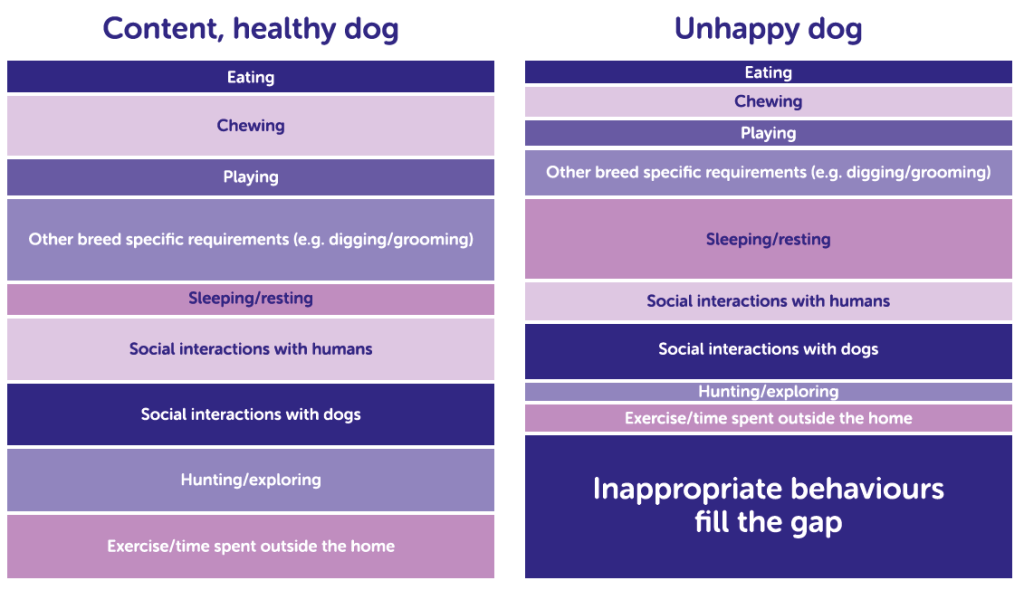Considering your pet’s emotional needs
As pet owners we are all very aware of our responsibility to ensure that our pets have appropriate access to food, water, exercise and sleep each day. However, how many of us think about our pets’ individual emotional needs beyond the above. Do we consider their needs for social interaction and play – whether with […]
As pet owners we are all very aware of our responsibility to ensure that our pets have appropriate access to food, water, exercise and sleep each day. However, how many of us think about our pets’ individual emotional needs beyond the above.
Do we consider their needs for social interaction and play – whether with other animals, people or toys? Do we think about their innate needs typical to their breed? For example, the need for working dogs to hunt and explore, or terriers to dig and chew. Whilst there are breed trends, of course every individual will vary in terms of exactly what they need, and should be considered on this basis. However, these needs are just as important to our pets as those for food, water, exercise and sleep, in order for them to live a content, fulfilled life. They are more likely to be in a happy and healthy state of well-being if we can provide opportunities for them to carry out these behaviours. We can consider our pets’ needs as filling a box, if their needs are all met appropriately then we can think of the box as being ‘full’. However, if we fall short in meeting any of their needs, a ‘gap’ is left in the box which is often filled with inappropriate behaviours such as destructive behaviour or excessive vocalisation.

If we can think of our pets in this way we are more likely to be able to empathise with their tricky behaviour and look to meet all their needs, as opposed to feeling the desire to punish them or think this is an inherent part of their character.
Avoid unintentionally reinforcing the behaviour
It is worth noting that an animal will not repeatedly carry out a behaviour unless there is something in it for them, this may be in the form of reward of relief and is easiest explained using examples:
- ‘The barking dog’: A dog whose family has recently had a baby may be receiving far less human contact and social interaction that they used to. If the dog starts barking and the owner tells them off, what might be thought of as a negative interaction, (the telling off) is seen by the dog as some much welcomed social interaction, i.e. the feeling of a reward, so they continue barking.
- ‘ The hissing cat’: Similarly a cat, whose bed has been placed in a busy part of the house and is rarely left in peace to sleep, may hiss when people approach; if the person moves away this may provide a feeling of relief to the cat, hence they continue to hiss when people approach.
In both of these examples, the owners are inadvertently reinforcing their pet’s behaviour, without realising they are doing so. We can see how the behaviour of the owner at the time is unlikely to improve the unwanted behaviour in the long run. Instead if they were to take a step backwards and think about the emotional state of the animal, whether their needs are being met and whether the behaviour is being unintentionally reinforced they may be able to have more of an impact. Let’s work through each of the examples above:
- ‘The barking dog’: the owner may realise the dog seems bit depressed and quiet in themselves, that they are not having all their needs for human or animal interaction met, their walks are shorter than they used to be, and yes the behaviour was unintentionally being rewarded. At this point rather than tell the dog off for barking (thereby reinforcing the behaviour) they may try to make changes at home to ensure they do spend more time interacting with the dog and find new ways to meet their needs for running around or playing with other dogs; it can also help to wait until the dog is calm to interact with them (thereby reinforcing calm behaviour as opposed to the barking).
- ‘The hissing cat’: on thinking about it, the owners acknowledge the cat always seems timid and anxious and never very relaxed. We know cats need on average 12-15 hours of sleep/ 24h, so perhaps this need is not being met where this cat’s bed is placed in a busy, noisy part of the house. It has been reported that human interactions can be positive for cats, if on their terms, so moving this cat’s bed to a quieter part of the house where they can sleep and choose themselves if/ when they want to interact with their owners may help to improve the undesirable hissing. Other common needs for cats include scratching and grooming, so providing opportunities for these may further help.
In many situations these changes, along with the use of an appropriate calming supplement, can be sufficient to have a really positive impact on an animal’s undesirable behaviour. Though there are many situations where professional behavioural support is required. Should you feel you may need further assistance from a professional behaviourist, please click here to see our article ‘Selecting a suitable behaviourist’ to help you find someone with a positive, up-to-date approach.
 Pet Owner
Pet Owner 



